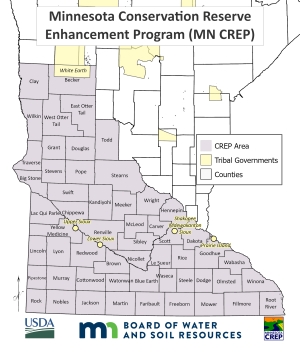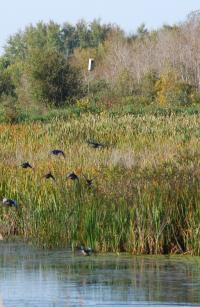The Minnesota Conservation Reserve Enhancement Program (MN CREP)
What is MN CREP?

MN CREP is a voluntary, federal-state funded natural resource conservation program that uses a science based approach to target environmentally sensitive land in 54 Counties in southern and western Minnesota. This is accomplished through permanent protection by establishing conservation practices via payments to farmers and agricultural land owners.
Here’s how it works:
- Landowners enroll in the federally-funded Conservation Reserve Progra
- m (CRP) for 14-15 years.
- CRP is administered by the USDA-Farm Service Agency (FSA). It uses agricultural land for conservation benefits, rather than farming or ranching.
- The same land is also enrolled into a state-funded perpetual conservation easement through the Reinvest in Minnesota (RIM) Reserve program, administered by the Minnesota Board of Water and Soil Resources (BWSR).
- Private ownership continues and the land is permanently restored and enhanced for conservation benefits.
MN CREP Objectives
MN CREP will protect up to 60,000 acres of the highest priority areas across 54 counties. It will:
- Target riparian areas and marginal agricultural land
- Restore hydrology, increase infiltration and provide flood mitigation
- Provide habitat for wildlife, non-game species and pollinators
- Reduce nitrate loading in drinking supplies
How will the land be restored and protected?
MN CREP will focus on four main Conservation Practices (CPs) that have been identified through the federal CRP:
1. Grass Filter Strips (CRP CP 21)
2. Wetland Restoration - Non Floodplain (CRP CP 23a)
3. Wetland Restoration – Floodplain (CRP CP 23)
4. Wellhead Protection Areas (CRP CP 2)
Why Enroll Now?
There are many reasons to consider MN CREP now, based on the long-term goals of the landowner. Some of these include:
Fair compensation – Payments for the land retirement portion of MN CREP are based on current CRP rental rates and RIM rates.
Rights retained – Landowners maintain ownership, including the right to control access to the land covered by the MN CREP CRP contract/RIM easement.
Returns on marginal cropland – MN CREP prioritizes and targets marginal cropland that is often associated with buffer areas and drained or altered wetlands. These lands often produce less than average crop yields, and are less profitable even when crop prices are high.
Impact on water quality and habitat – MN CREP focuses on both water quality and wildlife habitat. Enrolled land will deliver multiple benefits to ground and surface water, as well as provide habitat for pollinators and wildlife.
MN CREP versus CCRP – Land enrolled in MN CREP will receive additional CREP Incentives beyond what the Continuous Conservation Reserve Program (CCRP) provides. Based on current analysis, MN CREP total payment rates are at least 50 percent higher than CCRP payment amounts.
Option for re-enrolled CRP – Lands that are currently enrolled in CRP and eligible for re-enrollment during a MN CREP sign-up period may be eligible. This can result in seamless coverage of CRP annual payments and may allow for the existing vegetation to stay in place.
Quality native restoration – Restoration of the enrolled land will follow state and federal standards, and focus on native plant species. One hundred percent of these restoration costs will be covered by the CRP and RIM programs, leaving no out-of-pocket expenses to the landowner.
Enrollment
Enrollment for the MN CREP began in May of 2017 and will continue until funds are exhausted or the 60,000 acre limit is reached.
Contact your local SWCD to find out how to sign up for Minnesota CREP.

